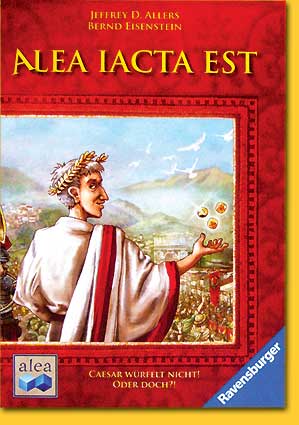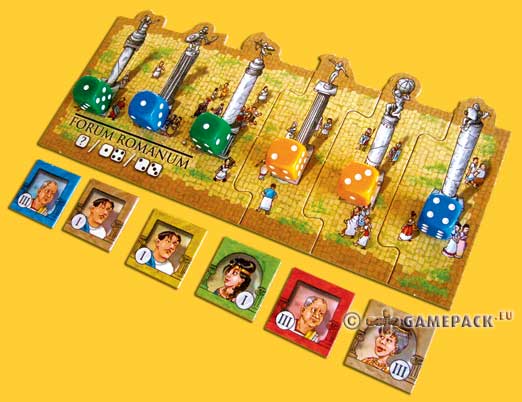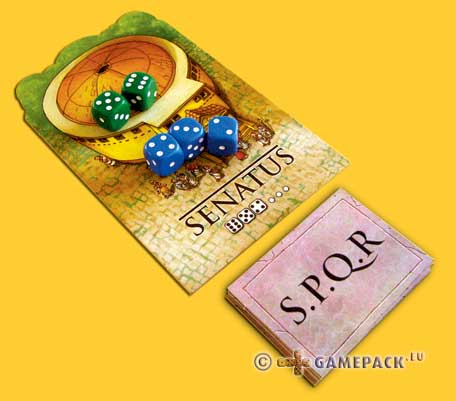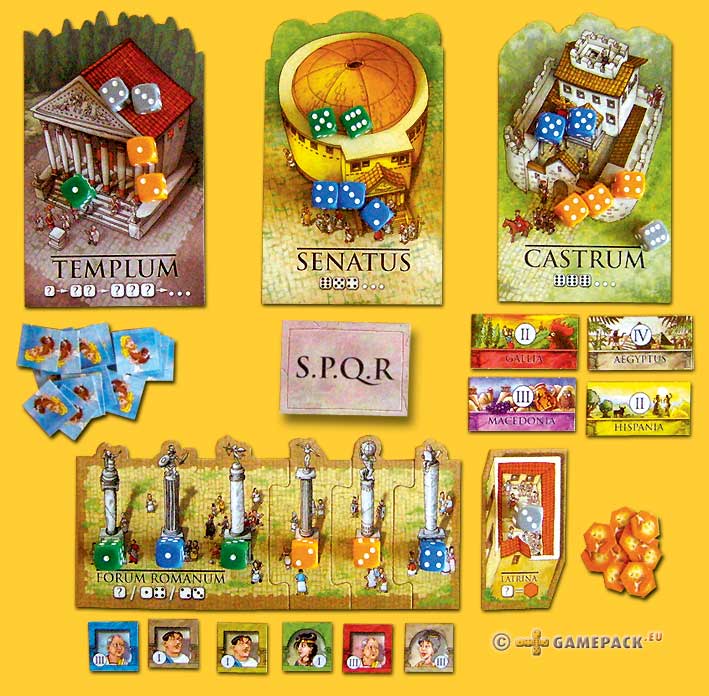Alea Iacta Est
Author: Jeffrey D. Allers & Bernd Eisenstein
Publisher: Alea / Ravensburger
Year: 2009
review by

| x |
|
|
|
|
|
|
|
|
|
|
|
|
|
|
|
|
|
|
|
|
|
|
|
|
|
|
|
|
|
|
|
|
|
|
|
|
|
|
|
|
|
|
|
|
|
|
 |
The last couple of years have been good to the dicing enthusiasts. Not the least among the game authors have been busy in this genre, resulting into dice versions of games like Ticket to Ride and Settlers of Catan, the latter originally already equiped with dice. The question arises, whether Alea has something interesting to add with 'Alea Iacta Est'.
The game, in a Roman setting, is played in several rounds: five rounds with 4 and 5 players, and six with 2 and 3. Each player is given eight dice in their own colour.
The starting player starts a round by throwing all dice at once. Depending on the outcome he places a number of dice at one of the four Roman buildings Templum, Senatus, Castrum, or Forum Romanum. This continues until one of the players has placed all of his dice in the buildings, which triggers the end of the round. All remaining dice of the players are placed in the fifth building of the game, the Latrina after which all buildings are scored. Goal of the game is obtaining provinces at the Castrum and manning them with patricians from the Forum Romanum, meanwhile trying to score some bonuses with the Senatus cards. The dice in the Templum and the Latrina will also give the players nice advantages. All items players obtain during the game will give them glory that are points, and the player with the most of it at the end of the game wins.
|
|
| x |
|
|
|
|
|
|
|
|
|
|
|
|
|
|
|
|
|
|
|
|
|
|
|
|
|
|
|
|
|
|
|
|
|
|
|
|
|
|
|
|
|
|
|
|
|
|
|
At the beginning of a round a number of province cards are placed face-up below the Castrum. The cards are randomly selected and their number equals the number of players. The points on these province cards vary from one to four, and come in five different colours/names. In a turn a player can place as many dice as he wants, provided that they all show the same number. If he starts, for instance, with a 1-3-3-4-4-4-4-6 throw, it might be a good idea to place the four 4's in the Castrum to try to have the first choice at the end of the round, but any other option could be a good idea, depending on the player’s priority and the available province cards. At the end of a round the result of the Castrum is evaluated by checking which player has the longest set of dice with equal numbers; he gets the first choice from the available province cards, followed by the player in second place, and so on. In case of equal length the highest number breaks the tie; 4-4-4-4 is better than 3-3-3-3. It is possible that a player obtains more than one province, since he is allowed to start a new but different set in a subsequent turn. Adding dice to an existing row also is allowed.
|
 |
| x |
|
|
|
|
|
|
|
|
|
|
|
|
|
|
|
|
|
|
|
|
|
|
|
|
|
|
|
|
|
|
|
|
|
|
|
|
|
|
|
|
|
|
|
|
|
|
| The provinces need to be populated with Patricians. These can be obtained in the Forum Romanum. At the beginning of a round a number of Patrician tiles is randomly selected and placed face-up below it. The number of tiles equals the number of pillars in the Forum, which depends on the number of players; a minimum of four, and a maximum of seven pillars. On each pillar a die can be placed during the round. A player can place one or two of his dice on the columns. Two dice can only be placed when his throw contains a 1-4 or a 2-3 combination. Otherwise any other single die can be placed. The dice are placed from left to right, low to high in the Forum. When all pillars are occupied, the rightmost die exits the Forum and goes to the adjoining Latrina. |
|
| x |
|
|
|
|
|
|
|
|
|
|
|
|
|
|
|
|
|
|
|
|
|
|
|
|
|
|
|
|
|
|
|
|
|
|
|
|
|
|
|
|
|
|
|
|
|
|
 |
|
|
| x |
|
|
|
|
|
|
|
|
|
|
|
|
|
|
|
|
|
|
|
|
|
|
|
|
|
|
|
|
|
|
|
|
|
|
|
|
|
|
|
|
|
|
|
|
|
|
| At the end of a round the player with the leftmost die in the Forum may choose first from the available Patrician tiles. Then the player with his die on the next column makes his selection, and so on, until all players have removed their dice from the Forum and chosen a Patrician tile. The Patricians are either male or female and vary in value from one to three points. Their colours correspond with the colours of the provinces they must be allocated to. At the end of the game a maximum of two Patrician tiles can populate a corresponding province, where it should be taken into account that only the evolutionary-technical succesfull male-female Patrician combination is allowed. Single Patricians without a province to live in have no value at the end of the game. |
|
| x |
|
|
|
|
|
|
|
|
|
|
|
|
|
|
|
|
|
|
|
|
|
|
|
|
|
|
|
|
|
|
|
|
|
|
|
|
|
|
|
|
|
|
|
|
|
|
 |
Interesting additional extras can be obtained by the Senate cards that can be obtained in the Senatus building. Here the goal is to get the longest 'straight'. A player can place or add as much dice as he wants in the Senatus, but he may not start a new straight. At the end of the round, the player with the longest straight may choose first from three Senate cards that are taken from the face-down stack of cards. The player in second place is given the second choice; any other players leave empty handed and their dice are placed on the Latrina.
|
|
| x |
|
|
|
|
|
|
|
|
|
|
|
|
|
|
|
|
|
|
|
|
|
|
|
|
|
|
|
|
|
|
|
|
|
|
|
|
|
|
|
|
|
|
|
|
|
|
| All Senate cards are good; some give bonus points depending on the provinces and Patricians obtained, others represent special provinces that will make Patrician placement more flexible. |
|
| x |
|
|
|
|
|
|
|
|
|
|
|
|
|
|
|
|
|
|
|
|
|
|
|
|
|
|
|
|
|
|
|
|
|
|
|
|
|
|
|
|
|
|
|
|
|
|
The Templum gives immediate points to the players involved. Cash on the nail, so to say. The first player here places only one die and takes one tile from the face-down, shuffled pile of Fortune tiles. The second player that favors the Templum must place two of his dice that have a higher sum than the previously placed individual die. The second player may take two Fortune tiles. This continues, with each new player placing an additional die totalling a higher sum, allowing him to take as many Fortune tiles as his amount of placed dice.
At the end of the round the player who has placed the most dice wins, and is allowed to keep two of his Fortune tiles. The other players are allowed to keep just one. Adding dice to a previous combination is also allowed here. The Templum is not included in a game with two and three players. |
 |
| x |
|
|
|
|
|
|
|
|
|
|
|
|
|
|
|
|
|
|
|
|
|
|
|
|
|
|
|
|
|
|
|
|
|
|
|
|
|
|
|
|
|
|
|
|
|
|
|
All dice at the end of a round that did not score are placed at the Latrina. Each die in the Latrina still earns a so-called repete chit; these chits can be used in subsequent rounds for a reroll of one or more dice. Per two unused repete chits one point is scored at the end of the game.
After the last round players allocate their Patricians tiles to the provinces with probably some of the provinces represented by Senate cards. Unpopulated provinces score one point less than indicated. Players add their points for provinces, allocated Patricians, Senate cards, Fortune chips and repete chits. The player with the highest sum wins!
|
|
| x |
|
|
|
|
|
|
|
|
|
|
|
|
|
|
|
|
|
|
|
|
|
|
|
|
|
|
|
|
|
|
|
|
|
|
|
|
|
|
|
|
|
|
|
|
|
|
| x |
|
|
|
|
|
|
|
|
|
|
|
|
|
|
|
|
|
|
|
|
|
|
|
|
|
|
|
|
|
|
|
|
|
|
|
|
|
|
|
|
|
|
|
|
|
|
| x |
|
|
|
|
|
|
|
|
|
|
|
|
|
|
|
|
|
|
|
|
|
|
|
|
|
|
|
|
|
|
|
|
|
|
|
|
|
|
|
|
|
|
|
|
|
|
 |
|
|
|
|
|
|
|
|
|
|
|
|
|
|
|
|
|
|
|
|
|
|
|
|
|
|
|
|
|
|
|
|
|
|
|
|
|
|
|
|
|
|
|
'Alea Acta Est' is an intelligent dice game, fun to play, and with a nice appearance. The mechanism of allocating the dice is an original twist to the worker placement mechanism that is so often used in recent years. Although players still suffer the randomness of the dice, there are still some tactical decisions to be made. The bonus cards may give the suggestion that the game can be tactically played, but the game is too short to allow this, especially with four or five players. With two and three players there is one more round, and this allows more room for some planning. But the overall advice is to play this game from the gut!
|
|
 |
The game is quite simple to play, but to get the rules right for all buildings a rule booklet of eight pages in small print was necessary, with an additional separate flimsy sheet to explain the Senate cards. This raises the question who Alea is targetting at: being a light game, the 'serious' board game player may be turned off by yet another dice game. On the other hand, families may be turned off by the large amount of text.
Contemplations set aside, what remains is a fun game that obviously has been designed and published with great care and attention. A player almost always has several interesting options, including interfering other players’ plans, and whatever the options, there is always some kind of reward at the end. All this makes 'Alea Iacta Est' better than the average (dice) game.
© 2009 Edwin van de Sluis
Alea Iacta Est, Jeffrey D. Allers & Bernd Eisenstein, Alea / Ravensburger, 2009 - 2 to 5 players, 9 years and up, 60 minutes
|
|
  |
|
|
|
|
|
|
|
|
|
|
|
|
|
|
|
|
|
|
|
|
|
|
|
|
|
|
|
|
|
|
|
|
|
|
|
|
|
|
|
|
|
|
  |
|
|
|
|
|
|
|
|
|
|
|
|
|
|
|
|
|
|
|
|
|
|
|
|
|
|
|
|
|
|
|
|
|
|
|
|
|
|
|
|
|
|
  |
|
|
|
|
|
|
|
|
|
|
|
|
|
|
|
|
|
|
|
|
|
|
|
|
|
|
|
|
|
|
|
|
|
|
|
|
|
|
|
|
|
|
  |
|
|
|
|
|
|
|
|
|
|
|
|
|
|
|
|
|
|
|
|
|
|
|
|
|
|
|
|
|
|
|
|
|
|
|
|
|
|
|
|
|
|
  |
|
|
|
|
|
|
|
|
|
|
|
|
|
|
|
|
|
|
|
|
|
|
|
|
|
|
|
|
|
|
|
|
|
|
|
|
|
|
|
|
|
|
| x |
|
|
|
|
|
|
|
|
|
|
|
|
|
|
|
|
|
|
|
|
|
|
|
|
|
|
|
|
|
|
|
|
|
|
|
|
|
|
|
|
|
|
|
|
|
|
Also read the  |
|
|
|
|
|
|
|
|
|
|
|
|
|
|
|
|
|
|
|
|
|
|
|
|
|
|
|
| x |
|
|
|
|
|
|
|
|
|
|
|
|
|
|
|
|
|
|
|
|
|
|
|
|
|
|
|
|
|
|
|
|
|
|
|
|
|
|
|
|
|
|
|
|
|
|
| x |
|
|
|
|
|
|
|
|
|
|
|
|
|
|
|
|
|
|
|
|
|
|
|
|
|
|
|
|
|
|
|
|
|
|
|
|
|
|
|
|
|
|
|
|
|
|
 |
|
|
|
|
|
|
|
|
|
|
|
|
|
|
|
|
|
|
|
|
|
|
|
|
|
|
|
|
|
|
|
|
|
|
|
|
|
|
|
|
|
|
 |
|
|
|
|
|
|
|
|
|
|
|
|
|
|
|
|
|
|
|
|
|
|
|
|
|
|
|
|
|
|
|
|
|
|
|
|
|
|
|
|
|
|
| x |
|
|
|
|
|
|
|
|
|
|
|
|
|
|
|
|
|
|
|
|
|
|
|
|
|
|
|
|
|
|
|
|
|
|
|
|
|
|
|
|
|
|
|
|
|
|
 |
|
|
|
|
|
|
|
|
|
|
|
|
|
|
|
|
|
|
|
|
|
|
|
|
|
|
|
|
|
|
|
|
|
|
 |
|
|
|
|
|
|
|
|
|
|
|
|
|
|
|
|
|
|
|
|
|
|
|
|
|
|
|
|
|
|
|
|
|
|
|
|